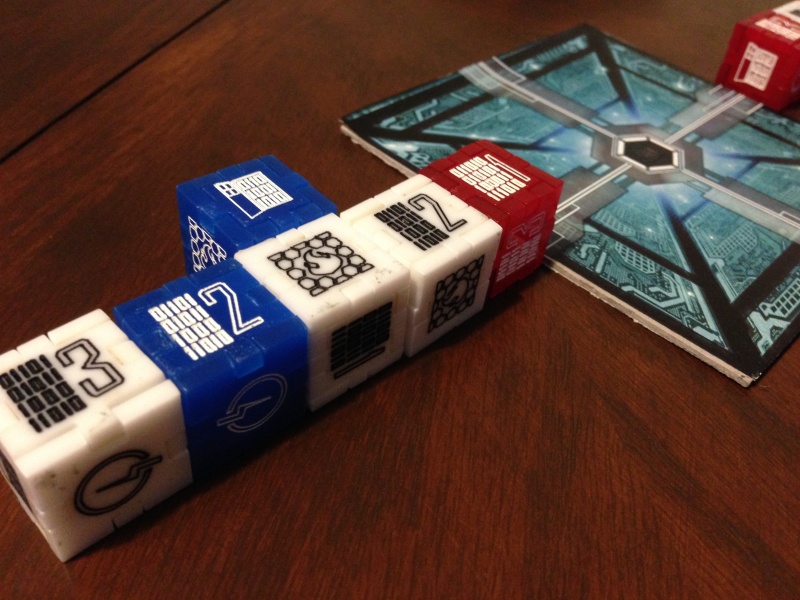Note: This preview uses pre-release components and rules. What you see here may be different from the final, published game.
 Any regular reader here probably knows that I’m a big fan of dice rolling games. To be honest, I’m just a fan of dice in general. (Craps is the only casino game I’ll play.) I just like how easy dice games are to get to the table. They are perfect when you want to relax for 20 minutes and don’t want to burn too many brain cells refreshing on complicated rules.
Any regular reader here probably knows that I’m a big fan of dice rolling games. To be honest, I’m just a fan of dice in general. (Craps is the only casino game I’ll play.) I just like how easy dice games are to get to the table. They are perfect when you want to relax for 20 minutes and don’t want to burn too many brain cells refreshing on complicated rules.
So that brings us to Firewall, the new dice game by Sarcastic Robot Games currently in funding on Kickstarter. In Firewall, players take on the role of hackers trying to gain access to a computer mainframe. However, those crazy hackers don’t play well with others and each data port will be a knock-down battle for control. Can you out-maneuver your fellow hackers?
Firewall is a dice rolling game for 2-8 players that plays in about 15 minutes.
Game Overview:

The main goal in Firewall is to control the most data ports. Each game, players will compete for anywhere between 2-4 data ports, with the amount of ports randomly chosen at the start of the game. On a players turn, they will roll three of their starting ten dice in their storage. They must then choose one of those dice to use in a data port. If a player can lock down a data port with the most programs running on it, they will gain a step towards winning the game. At the end of the game, whoever controls the most data ports wins.
How to Play:
Firewall has easy-to-learn rules that make it very quick to get to the table. Each player starts with ten dice in their “storage.” The mainframe board is placed in the center of the table and a number of data ports to use are randomly selected. Each player takes a turn beginning with the start player and rotating clockwise.
On a players turn, they must roll three of their dice from their storage (or as many as they have). Then, they must choose one of those three dice to play onto a data port. A player may also take one of their dice and move it to their “RAM.” A die in a player’s RAM may be placed instead of one of the three rolled dice on their turn. A player can only have one die in their RAM at a time. After their die is placed, the next player takes their turn.
Possible die options are:
Program: Numbering from 1-3, this is how a player controls a port.
Firewall: This stops other players from adding dice to the port. If a port ever has two firewalls from one player, it is locked down for the rest of the game to everybody.
Backdoor: A player can play this on a firewall to gain access back to the port. This only works if a player hasn’t played a second firewall already.
Spike: This will remove any die from a port. Both the spike and the chosen die are removed from the game. Does not work on a locked down port.
And that’s all there is to it. Once all the ports are locked down or the players have run out of dice to roll, the game is over and the player who controls the most ports wins.

Game Experience:
I was a big fan of the really horrible 90’s movie Hackers, so I immediately was drawn to Firewall’s theme. Hacking a supercomputer just sounds cool. That’s also one of the reasons I really like Netrunner, but I digress.

One of the great things about Firewall is how interactive it is. In many dice games, you simply watch other players take their turn and wait for your own. Not so in Firewall. Players are actively competing against each other for the same ports. Judicious use of the spike dice can not only turn the tide of a port battle, but make you some bitter enemies as well. No one likes seeing their well-laid plans ruined by another player. Overall, I was pleasantly surprised with the amount of interaction in Firewall.
The rules also help to make the game really accessible. I was able to teach it to Mrs. BoardGameQuest in a matter of minutes and she had no issue picking it up. While the theme might seem complex, you don’t have to be a hacker to understand the nuances of Firewall. The dice make sense as to what they do even for the computer illiterate. You don’t have to be a 31337 hacker to enjoy Firewall.
Any criticism I’d have of Firewall is going to land squarely in the camp of any dice game. There will be randomness in the game, probably a great deal of it. But that’s any dice game really. But I know some gamers hate when games are too random. I only bring this up to let you know that if you hate dice games because they are too random, then there is nothing in Firewall will change your mind.
Crabby gamers who hate dice aside, I think Firewall is a good addition to the dice rolling genre. The theme is fresh and I like how interactive the game is. The game also scales pretty well. We’ve played it from 2 to 4 players and all have been enjoyable.
Final Thoughts:

For those of us that enjoy slinging some dice on your tabletop, Firewall is absolutely worth a look. The play time is about perfect for a dice game (about 15-20 mins), the theme works really well and the game is highly interactive. Not every dice game can make these claims so that puts Firewall in a good light in my book.
If you are interested in the game, it’s currently in funding on Kickstarter and scheduled for delivery in December 2013. A pledge of $31 will get you a copy of the game and any stretch goals. You have until Monday, November 18th to become a backer so head over today if you are interested.
As always, we don’t post ratings for preview copies as the components and rules may change from the final game. Check back with us after the game is produced for a full review.




















